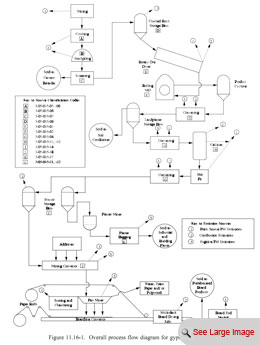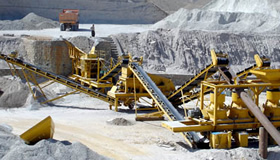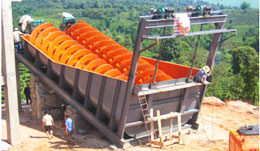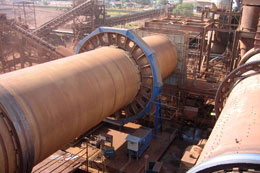-
Sand Making Crusher
- PCL-Vertical Shaft Impact Crusher
- SBM Hydraulic VSI Crusher
- VSI5X Series Impact Crusher
Gypsum mineral processing
Gypsum Manufacturing Process Description

Gypsum is calcium sulfate dihydrate (CaSO4 2H2 O), a white or gray naturally occurring mineral. Raw gypsum ore is processed into a variety of products such as a portland cement additive, soil conditioner, industrial and building plasters, and gypsum wallboard. To produce plasters or wallboard, gypsum must be partially dehydrated or calcined to produce calcium sulfate hemihydrate (CaSO4 ½H2 O), commonly called stucco.
A flow diagram for a typical gypsum process producing both crude and finished gypsum products is shown in Figure 11.16-1. In this process gypsum is crushed, dried, ground, and calcined. Not all of the operations shown in Figure 11.16-1 are performed at all gypsum plants. Some plants produce only wallboard, and many plants do not produce soil conditioner.
Gypsum ore, from quarries and underground mines, is crushed and stockpiled near a plant. As needed, the stockpiled ore is further crushed and screened to about 50 millimeters (2 inches) in diameter. If the moisture content of the mined ore is greater than about 0.5 weight percent, the ore must be dried in a rotary dryer or a heated roller mill. Ore dried in a rotary dryer is conveyed to a roller mill, where it is ground to the extent that 90 percent of it is less 149 micrometers (µm) (100 mesh). The ground gypsum exits the mill in a gas stream and is collected in a product cyclone. Ore is sometimes dried in the roller mill by heating the gas stream, so that drying and grinding are accomplished simultaneously and no rotary dryer is needed. The finely ground gypsum ore is known as landplaster, which may be used as a soil conditioner.

In most plants, landplaster is fed to kettle calciners or flash calciners, where it is heated to remove three-quarters of the chemically bound water to form stucco. Calcination occurs at approximately 120 to 150°C (250 to 300°F), and 0.908 megagrams (Mg) (1 ton) of gypsum calcines to about 0.77 Mg (0.85 ton) of stucco.
In kettle calciners, the gypsum is indirectly heated by hot combustion gas passed through flues in the kettle, and the stucco product is discharged into a "hot pit" located below the kettle. Kettle calciners may be operated in either batch or continuous mode. In flash calciners, the gypsum is directly contacted with hot gases, and the stucco product is collected at the bottom of the calciner. At some gypsum plants, drying, grinding, and calcining are performed in heated impact mills. In these mills hot gas contacts gypsum as it is ground. The gas dries and calcines the ore and then conveys the stucco to a product cyclone for collection. The use of heated impact mills eliminates the need for rotary dryers, calciners, and roller mills.
Gypsum and stucco are usually transferred from one process to another by means of screw conveyors or bucket elevators. Storage bins or silos are normally located downstream of roller mills and calciners but may also be used elsewhere.
- Limestone Crusher
- Barite Crusher
- Granite Crusher
- Kaolinite Crusher
- Calcite Crushing
- Tombarthite Crusher Mill
- Bentonite Grinding Plant
- Basalt Ore Crusher
- Lignite Crusher Mill
- Silica Ore Crusher
- Tin Ore Mine
- Lead and Zinc Ore Crusher
- Ochre Crusher Mill
- Garnet Crusher
- Mica Crusher
- Asbestos Crusher
- Manganese Ore Crusher
- Talc Crusher Mill
- Feldspar Crusher
- Iron Ores Crusher
- Dolomite Crusher
- Quartz Crusher
- Gypsum Crusher
- Calcium Carbonate Grinding
- Gypsum mineral processing
- Gypsum powder production
- Gypsum mineral beneficiation
- Gypsum mineral quarry
- Recycle gypsum processing
- Gypsum mining machine
- About Us
- |
- Service
- |
- News & Events
- |
- Contact Us
- |
- Resources
- |
- Showroom
Aggregate Crusher
Artificial Sand Making
Ballast Crushing Machine
Basalt Stone Crusher
Barite Mine Process
Beneficiation Plant
Bentonite Crusher
Bentonite Milling
Calcium Carbonate Crusher
Calcium Carbonate Grinding
Cement Grinding
Concrete Crusher
Coal Crusher
Copper Crusher
Cement Mill
Chrome Mining Process
Copper ore Beneficiation
Coal Processing
Coal Pulvarizer
Feldspar Crushing
Feldspar Grinding
Flotation Machine
Gold Crusher
Gold Mine Equipment
Gold Processing Machinery
Granite Crusher
Granite Crushing Machine
Granite Quarry Equipment
Gypsum Crusher
Gypsum Mining
Gypsum Powder Production
Iron Ore Beneficiation
Iron Ore Crusher
Kaolin Processing Plant
Limestone Crusher
Silica Sand Crusher
Iron Ore Mining Equipment
Cement Production Line
Talc Production Line
Quartz Crushing Machine
Limestone Mining Process
Manganese Benificietion
























